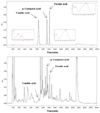1. Lin JW, Chiang HM, Lin YC, Wen KC. Natural products with skin-whitening effects. J Food Drug Anal. 2008; 16(2):1–10.
2. Pillaiyar T, Manickam M, Jung SH. Recent development of signaling pathways inhibitors of melanogenesis. Cell Signal. 2017; 40:99–115.


6. Shin BY, Jung BR, Jung JG, Cho SA, Bang MA. Inhibitory effects on melanin production in B16 melanoma cells of fallen pear. J Korean Soc Food Sci Nutr. 2017; 46(3):320–326.

7. Arndt KA, Fitzpatrick TB. Topical use of hydroquinone as a depigmenting agent. JAMA. 1965; 194(9):965–967.


8. Funayama M, Arakawa H, Yamamoto R, Nishino T, Shin T, Murao S. Effects of alpha- and beta-arbutin on activity of tyrosinases from mushroom and mouse melanoma. Biosci Biotechnol Biochem. 1995; 59(1):143–144.
10. Mishima Y, Hatta S, Ohyama Y, Inazu M. Induction of melanogenesis suppression: cellular pharmacology and mode of differential action. Pigment Cell Res. 1988; 1(6):367–374.


11. Chang TS. Natural melanogenesis inhibitors acting through the down-regulation of tyrosinase activity. Materials (Basel). 2012; 5(9):1661–1685.


12. Fuyuno I. Spotlight turns on cosmetics for Asian skin. Nature. 2004; 432(7020):938.

13. Elhadi Aborus N, Čanadanović-Brunet J, Ćetković G, Tumbas Šaponjac V, Vulić J, Ilić N. Powdered barley sprouts: composition, functionality and polyphenol digestibility. Int J Food Sci Technol. 2016; 52(1):231–238.

14. Lahouar L, El-Bok S, Achour L. Therapeutic potential of young green barley leaves in prevention and treatment of chronic diseases: an overview. Am J Chin Med. 2015; 43(7):1311–1329.


15. Byun AR, Chun H, Lee J, Lee SW, Lee HS, Shim KW. Effects of a dietary supplement with barley sprout extract on blood cholesterol metabolism. Evid Based Complement Alternat Med. 2015; 2015:473056.

16. Seo WD, Yuk HJ, Curtis-Long MJ, Jang KC, Lee JH, Han SI, et al. Effect of the growth stage and cultivar on policosanol profiles of barley sprouts and their adenosine 5′-monophosphate-activated protein kinase activation. J Agric Food Chem. 2013; 61(5):1117–1123.


17. Meng TX, Irino N, Kondo R. Melanin biosynthesis inhibitory activity of a compound isolated from young green barley (Hordeum vulgare L.) in B16 melanoma cells. J Nat Med. 2015; 69(3):427–431.


18. Kamiyama M, Shibamoto T. Flavonoids with potent antioxidant activity found in young green barley leaves. J Agric Food Chem. 2012; 60(25):6260–6267.


19. Hosoi J, Abe E, Suda T, Kuroki T. Regulation of melanin synthesis of B16 mouse melanoma cells by 1 alpha, 25-dihydroxyvitamin D3 and retinoic acid. Cancer Res. 1985; 45(4):1474–1478.

20. Lee KT, Kim BJ, Kim JH, Heo MY, Kim HP. Biological screening of 100 plant extracts for cosmetic use (I): inhibitory activities of tyrosinase and DOPA auto-oxidation. Int J Cosmet Sci. 1997; 19(6):291–298.


21. Boo YC. p-Coumaric acid as a skin whitening agent: novel findings on its ability to attenuate melanin synthesis. H&PC Today. 2013; 8(1):34–36.
22. Jun HJ, Lee JH, Cho BR, Seo WD, Kim DW, Cho KJ, et al. p-Coumaric acid inhibition of CREB phosphorylation reduces cellular melanogenesis. Eur Food Res Technol. 2012; 235(6):1207–1211.

23. Lim JY, Ishiguro K, Kubo I. Tyrosinase inhibitory p-coumaric acid from ginseng leaves. Phytother Res. 1999; 13(5):371–375.


24. Park HJ, Cho JH, Hong SH, Kim DH, Jung HY, Kang IK, et al. Whitening and anti-wrinkle activities of ferulic acid isolated from Tetragonia tetragonioides in B16F10 melanoma and CCD-986sk fibroblast cells. J Nat Med. 2018; 72(1):127–135.


25. Maruyama H, Kawakami F, Lwin TT, Imai M, Shamsa F. Biochemical characterization of ferulic acid and caffeic acid which effectively inhibit melanin synthesis via different mechanisms in B16 melanoma cells. Biol Pharm Bull. 2018; 41(5):806–810.

26. Ha DH, Choi YJ, Yoo SM. Effects of vanillic acid on the cell viability and melanogenesis in cultured human skin melanoma cells damaged by ROS-induced cytotoxicity. J Exp Biomed Sci. 2007; 13(4):349–354.









 PDF
PDF ePub
ePub Citation
Citation Print
Print




 XML Download
XML Download